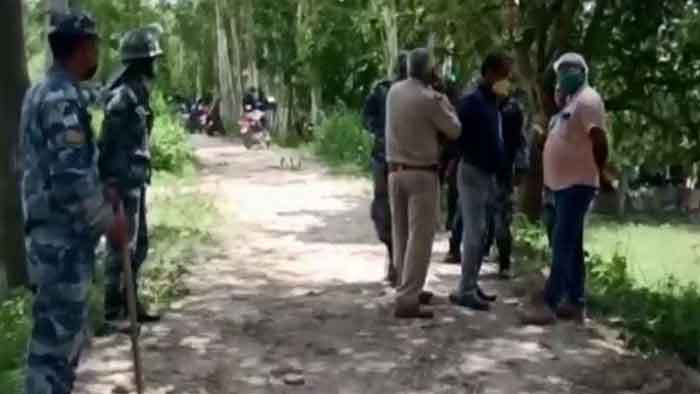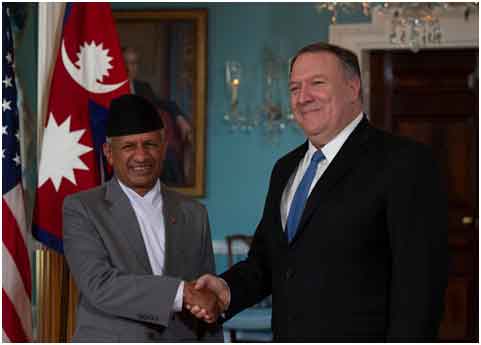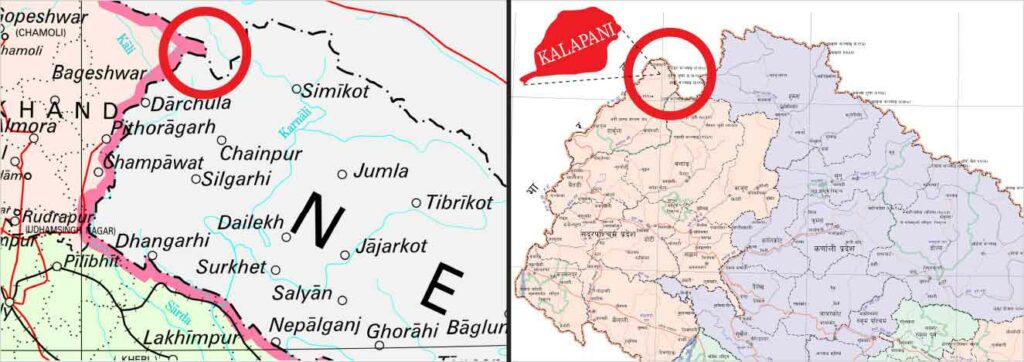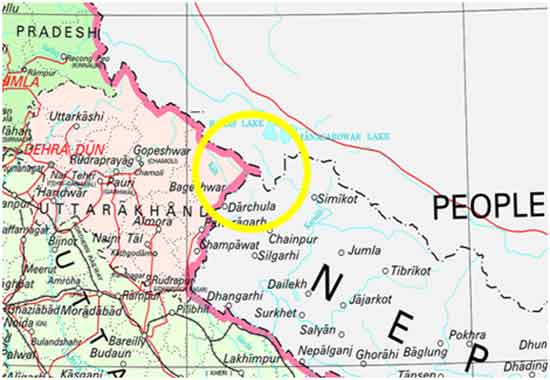This is Part-4 of a series of articles on a crisis in India-Nepal relations that led to mutual allegations of a cartographic war, and smacked of being a part of cold war against China. It is a still unfolding controversy, being reported and analysed exclusively for the readers of Countercurrent.org.
Part-4 now being published, deals with the international context and import of the still unfolding controversy.
Countercurrents.org published a series of articles on the controversy that burst out amid Covid-19 crisis, with many dimensions, national and international.
Part-1 on May24: India-Nepal Border Issue Raked Up, Relations Strained Once Again.
Part 2 on May26: India-Nepal Embittered Relations : Much beyond a Border Dispute
Part 3 on May29: “Nepal map runs into Parliament wall” : Who built this wall? India!
Severe setback to the “Global Leader Modi” in foreign policy on the First Anniversary
A severe setback to Prime Minister Modi in foreign policy greets him on the First Anniversary of NDA-2. The Global leader – very much promoted, in a latest Open Letter to People of India, by himself to mark the Anniversary – has met with this fate. And now he and his regime can win a prize for how to win enemies, not only abroad but within India where crores of migrant labor saw and experienced realities of life, in an inhuman system of exploitation and comprador crony capitalism.
Even as PM Modi’s regime was celebrating one year in office, it was faced with a severe setback in its immediate neighborhood policy in Nepal. And this is not in Muslim Pakistan, but Hindu-majority Nepal. Since the last part-3 was published, Times of India May 31 reported:
“Despite Modi’s repeated outreach to Nepal, managing ties has been a challenge , the situation becoming more fraught after PM Oli began to turn towards China, even for his own survival.”
“With Nepal’s chief opposition party, Nepali Congress endorsing the constitutional amendment… it is likely to go through with the required two-thirds majority, a development that will worsen the crisis in India-Nepal relations…it will serve to shore up PM Oli’s nationalist credentials, and the anti-India stance that goes with it.”
Nepali Congress decision in its Working Committee meet on May 30 was a “foregone conclusion,” …because “ the issue has fired the cadres and the public opinion” in Nepal. The Madhesi-based parties, like RPP, SJP, RJP-Nepal all fell in line.
“ The mood in New Delhi is gradually hardening – there is an acknowledgement that perhaps the Lipulekh road should not have been opened with such fanfare, and that Army Chief General MM Naravane, whose comment that Nepal was acting at China’s behest added to the fire and angered the Nepal army, should have been more discreet. But Nepal’s subsequent actions will drive the two countries to a difficult place.”
(On China too, allegations of intrusions were diluted. TOI reported.) Asked whether : “ Chinese troops had intruded deep into Indian territory across LAC in Ladakh, Defence Minister Rajnath Singh said: There are perceptional differences with China over the LAC.”
TOI’s last point can be better understood by this report from Nepal :
Criticising Indian Army Chief Manoj Mukund Naravane’s remarks on Kathmandu acting on “behest of someone” over the Lipulekh issue, Nepal Defence Minister Ishwor Pokhrel has said that the statement was an insult to the nation’s history and was made ignoring its social characteristics and freedom.
“Such a statement is an insulting statement made by ignoring Nepal’s history, our social characteristics and freedom. With this, the Indian CoAS has also hurt the sentiments of the Nepali Gurkha army personnel who lay down their lives to protect India. It must now become difficult for them to stand tall in front of the Gurkha forces,” (An interview with the daily, The Rising Nepal, on May 22.)
Of course these are welcome setbacks, even if temporary, because Big Brother India needed to be curbed, in its own interest.
*** ***
“China interferes in Nepal to save Communist Party government”
That is the curious title of a report in Economic Times (ET), May 02, 2020. It implied the Govt was about to be toppled, but was saved.
Curious because we are accustomed to news, thanks to US hegemony and its CIA, of murders (or attempts to murder) of Presidents, bombing of Presidential palaces, military coups, regime changes by subtle means, including use of dollars. And not many cases of saving a govt., as in this case.
The regional hegemon India and its RAW had their own share in such (mis)deeds, experienced by almost all of its neighbors in South Asia, though, one must concede, on a much smaller scale than by US. Modi-led India is emulating its predecessors in these nefarious games. Nepal itself witnessed regime changes at the behests of India, including Modi-led India. A new word, Sikkimization, was added to the political lexicon by India, and a word feared by many in Nepal. In 2016, Oli, CPN- UML leader himself blamed Delhi-US collusion for toppling his govt. He was back in power later, with a new alliance with CPN-Maoists, which later merged to form a new party, NCP. Now again, similar attempts by the same forces were made, unsuccessful for the present. This was the context of the reports by ET and others, given below:
Thus it was indeed news that China intervened to save a government that was headed by a sister communist party. And the means adopted were, as alleged by Indian agencies, meetings by a diplomat, and a phone call by President Xi Jinping : Both legitimate regular diplomatic means. But it raised the concerns in India.
The ET reported : Chinese Ambassador to Nepal, (Ms.) Hou Yanqi, met NCP leaders Prachanda, Madhav Kumar Nepal, (besides Nepal’s President Bidya Devi Bhandari) at a time when they were determined on ousting PM KP Oli, amid intra-party row. Oli proposed party Vice President Bam Dev Gautam as the new PM during the party’s Secretariat meeting held on April 29.
And New Indian Express, May 2, added she met them again on May 2; expressed hope that the NCP would remain united despite the dispute; took assurance from Prachanda that even if they had to change the PM or the party president, they will not split the party and remain united. Chinese President Xi Jinping also held a telephonic conversation with his Nepali counterpart, Bhandari on April 27. Oli-led government brought two ordinances, to keep himself in office, but later withdrawn. Others also reported variously.
Then came news of India’s Defence Minister inaugurating on May 8 , in Kalapani area, a strategic road leading to Manas Sarovar in China’s Tibet, presented as a new facility for pilgrims. That was in what was admittedly a disputed area in the tri-junction of China, Nepal and India’s Uttarakhand.
Nepal was not even informed, let alone being consulted. That led to an exchange of words; India’s refusal to hold talks, ostensibly because of covid-19 crisis, requested by Nepal which wondered where was the hurry to inaugurate a road in Covid days. Nepal requested talks not only presently. Since last November Nepal formally asked for talks, in the wake of a NEW map issued by India showing its controversial and sudden re-organization of JK into UTs. In the event, Nepal too issued on May 20 a new map that led to mutual allegations of a cartographic war. Both maps included the areas around Kalapani.
zeenews.india, more inventive, carried forward the above reports, on May 21, 2020, with the title : Nepal PM KP Sharma Oli raises border dispute with India to repay China for saving his government. As if Nepal had no interest in its own territorial integrity!
“Earlier, New Delhi used to play a crucial role in Nepal politics but now China has emerged as a dominant player in the politics of the Himalayan nation”, lamented Zeenews : “In the past, Nepal had never objected to India’s road construction till Lipulekh pass” that led to the cartographic war, or the maps controversy. A falsehood: Nepal has been raising this dispute since decades, and India agreed to discus the same, as can be seen from official Indian documents, including joint statements. (the last one of August4, 2014).
Indian Army Chief MM Naravane stated, as widely reported, that if Nepal is raising the India’s road issue, it is doing so at ‘someone else’s behest’, hinting at China. And this rubbed Nepal from the wrong end, drawing rebuttals from Nepal and its army , of which Indian Chief is also an Honorary Commander. There are seven Gorkha regiments in Indian army, including thousands of Nepal’s citizens, a British India’s colonial tradition still continuing. There are more than one lakh Nepali army men drawing pensions from Indian army.
“Yanqi understood to have sought Nepal’s support against an international movement targeting China,” added Zeenews, very close to Modi regime, referring to Covid-19 crisis, and WHO meet demanding an international probe.
(Historic World Health Assembly ends with global commitment to COVID-19 response. See report in Countercurrent.org. May 21, 2020.)
Yes, an “international movement” targeting China during the same period ; the following were among media headlines in these few weeks:
US and West support to and legislation regarding Hong Kong protests, to Taiwan, and Uighur Muslims, Trump’s plans and Bills to apply sanctions against China as part of a trade war; US blaming China for “aggressive behaviour and worldwide border disputes”, “obstruction to freedom of navigation” as in South China Sea, “suppression of human rights” and media freedom in China…not to speak of egging on Nepal against India. This is apart from a Covid19-related resolution against China in WHO forum, sponsored by Western initiative, and India joined in it.There were petitions by US and Indian entities in International Court of Justice demanding damages worth trillions of dollars.
All these moves led by a US that waged aggressive wars, still going on, that killed millions of civilians in the last few decades.
The reports also showed how a “small land-locked Nepal” choked into submission earlier by periodic blockades, imposed by India that (mis-)used its unequal Trade and Transit Treaty, increasingly asserted itself with Chinese help coming through a network of Trans Himalayan communications network, apart from enhanced trade worth 130 crore dollars, quite big for a small Nepal, thereby diminishing opportunities to Indian and MNC businesses.
“Earlier, New Delhi used to play a crucial role in Nepal politics but now China has emerged as a dominant player in the politics of the Himalayan nation,” lamented Zeenews. Has China Weaned Nepal Away From India? was another media story.
Yet another green-horn media outlet rabidly reported the events, with the title:
Nepalese govt is officially China’s puppet regime (tfipost.com, May 5). Obviously because it was saved by China from being toppled. TFI’s full form is apt and worth noting: The Frustrated Indian. It reported : China brazenly meddles in political affairs of Nepal, saves communist govt from falling. So Nepal’s becomes a puppet regime!
One can see how new chauvinist, jingoist, misinformation outlets are being floated. It claimed “a vibrant community of 100+ Writers and almost 4 Million Monthly Readers. And We have just begun.” Its complaint is noteworthy: “The mainstream media narrative of India is highly tilted towards the left. Hence an average news reader of India gets to read news with “liberal” doses of “left-arm” spin.TFIPOST was created to provide an alternate Center-Right narrative. We are very new and already one of the most read and appreciated blogging platforms in the country.
“It is also believed that China engineered the grand alliance of the two communist parties in Nepal In 2018, KP Sharma Oli and Pushpa Kamal Dahal, better known as Prachanda, had joined hands to form the Nepal Communist Party.” So it is a crime to unite, while to split and topple is a legitimate democratic activity.
*** ***
Nepal’s kathmandupost.com reported, May 2, 2020, more objectively :
In a series of meetings, Chinese envoy calls for unity among ruling party members.
According to individuals familiar with the meetings, Hou discussed three primary issues—the ongoing internal crisis in the ruling party, China’s assistance to Nepal to fight Covid-19, and Nepal’s support against the international politicisation of Covid-19 where a number of countries, including the USA , are trying to hold China accountable for the pandemic.
She was seeking support (of Nepal and NCP) to act as a bulwark against an international movement targeting China.
Hou’s series of meetings precede a crucial ruling party Secretariat meeting on May 2 .The Chinese Embassy in Kathmandu described the meetings as regular working communications.
Analysts say that while China is interested in keeping the Nepal Communist Party intact, it doesn’t have any preferences when it comes to who leads the government.
Oli’s position in the party has become so tenuous that Dahal, Nepal and senior leader Jhala Nath Khanal have all asked him to resign, leading to fears among party members that the party could split.
“We should see these meetings in three contexts. One, China’s diplomatic outreach after the Covid-19 outbreak; second, China’s medical and other assistance to Nepal; and third, China’s interest in the emerging political situation in our party,” said Bishnu Rijal, deputy chief of the party’s international relations department.
According to Rijal, Beijing is concerned over disputes in the ruling party.
“They have been advising us to remain united and not indulge in disputes,” Rijal told the Post. “They have also suggested that top leaders take into account the people’s verdict, peace and development.”
Hou’s meetings with ruling party leaders came on the heels of Chinese President Xi Jinping’s telephone conversation with President Bidya Devi Bhandari earlier this week. While offering assistance to Nepal in the fight against Covid-19, Xi also discussed bilateral cooperation and Nepal-China affairs.
The Chinese Foreign Ministry said in a statement that Xi expressed confidence that the Nepali government and people will beat the virus at an early date, under the leadership of President Bhandari and Prime Minister Oli.
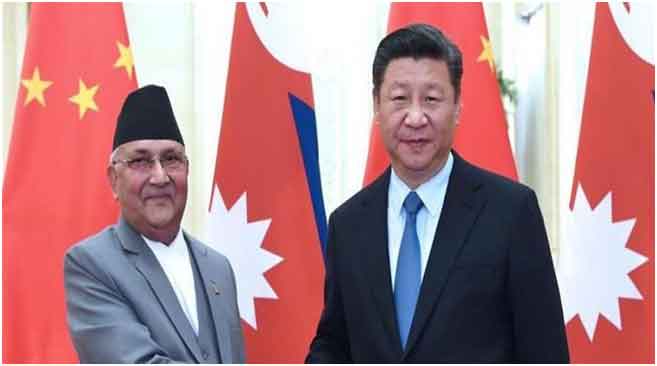
Nepal’s PM K.P. Sharma Oli with Chinese President Xi Jinping in June 2018. Photo: China_Amb_India/Twitter
“Xi said that after the defeat of Covid-19, the two sides should continue to implement the consensus on cooperation in various fields reached by the two leaders during their mutual visits last year, and advance the sustained growth of the China-Nepal strategic partnership of cooperation,” reads the statement.
The ruling Nepal Communist Party was born out of a merger between Oli’s CPN-UML and Dahal’s Maoist Centre in May 2018, something that many believe was supported by the Chinese following a period of tumult in Nepal after the promulgation of the constitution in 2015 and the subsequent Indian blockade.
The ruling Nepal Communist Party and the Communist Party of China have since strengthened ties and increased bilateral visits.
While China has increased its presence in Nepal in recent years, primarily via aid and numerous big-ticket projects, it has remained cautious about not interfering in Nepal’s internal matters.
Nepal receives the highest amount of foreign direct investment from China
While Nepal has committed to the ‘One-China’ policy, a stable Nepal has been Beijing’s reiteration.
“Due to ideological closeness, naturally the Chinese prefer a communist government in Nepal,” Sapkota told the Post. “But I don’t think they have any preferences when it comes to who leads the government.”
Oli-led govt.was later toppled by Modi-led India as seeen above.
“Earlier, New Delhi used to play a crucial role in Nepal politics but now China has emerged as a dominant player in the politics of the Himalayan nation”, lamented Zeenews. That is the source of India’s concerns and frustrations.
*** ***
India Should Realise China Has Nothing to Do With Nepal’s Stand on Lipulekh, wrote Biswas Baral, the editor of The Annapurna Express, a weekly newspaper published from Kathmandu.
In his comment of May 19, he recalled some aspects of history of the dispute and explained that Nepal protested India’s expansion into Nepal, long before communists formed govt there:
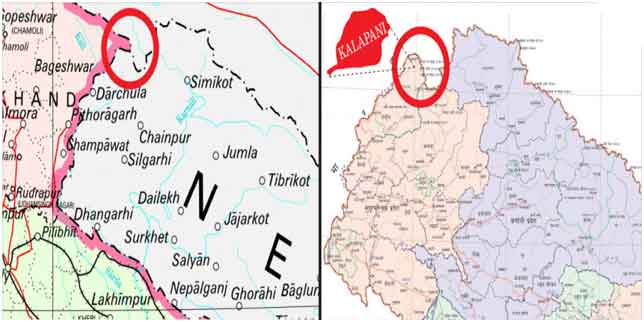
India’s new political map (left) includes the disputed territory of Kalapani. Nepal’s official map (right) also shows Kalapani inside its border. Map images via India’s Home Ministry & Nepal’s Survey Department. Source : Kathmandu Post.
India has had an army base in the Kalapani region near the Lipulekh pass since the early 1950s. Following Nepal’s request, India withdrew 16 of the 17 border army posts in 1970 but not the one at Kalapani. The Nepali monarch at the time, King Mahendra, whom the Indians saw as close to China, did not want to further alienate the Indians and didn’t object to India’s retention of the post there.
Since the revival of democracy in Nepal in 1990, successive Nepali governments have requested India to remove the post and return the land to Nepal. India has stayed put…
India had kept its army installation in Kalapani as the area was of high strategic value. The high ground of India’s army post there allows it to monitor the highland passes with Tibet far into the distance. Following the 1962 war, India felt that it could not leave the sector unattended.
India has given Nepali officials reason to believe that the army post is as important to it today as it was in 1962, even though it can now monitor the movement on the segment through drones or satellites…
Things came to a boil in November 2019 when India published a new edition of its political map to take into account the bifurcation of Jammu and Kashmir. This map showed the Kalapani territory, including Lipulekh pass, whose ownership Nepal disputes, as falling entirely within Indian territory.
Even though Lipulekh is acknowledged to be a tri-junction point, most Nepalis have grown up believing that the rest of the Kalapani region belongs entirely to Nepal. So each time India’s cartographic assertions come as a shock.
The new road in Lipulekh and the Indian army chief’s unequivocal statement that most of Kalapani falls within India has reignited anti-India fervour that had reached an apogee during the 2015-16 border blockade…
The Indian army chief’s statement sparked a furore in Nepal after he hinted at China’s hand behind Kathmandu’s decision to lodge a complaint against the new road. Nepal’s foreign minister, Pradeep Gyawali, summoned Vinay Mohan Kwatra, the Indian envoy to Nepal, and handed him an official note of protest.
Naravane’s statement was both inaccurate and insensitive. The fact is that the Nepal government took India on over Lipulekh because there was immense public pressure to do so…
China had been, for some time, cultivating the Nepali communists and urging the two top communist forces in the country—the CPN-UML and the UCPN (Maoist)—to unite. This was part of Beijing’s plan to have a strong and stable power centre in Kathmandu after the abolition of the Nepali monarchy in 2008. It calculated, rightly so, that the communists would soon be the strongest force in the country.
If Oli doesn’t get the (Indian) message, Nepali requests to settle Kalapani will continue to fall on deaf ears, and New Delhi could further harden its position vis-à-vis the Oli government… India is quietly putting together an anti-Oli coalition, for instance, by brokering the recent merger between the two biggest Madhesi parties.
Among the more extreme (and unlikely) options being floated by protestors angry at the stalemate: the complete sealing of the Nepal-India border, sending the Nepal Army into Kalapani, resurrecting the old demand for ‘Greater Nepal’.
The demand for Greater Nepal—the restoration of nearly half of Nepal’s territories ceded to India’s former British rulers—is an interesting one. If India is seemingly not ready to accept the borders demarcated by the 1816 Treaty of Sugauli, the argument goes, why can’t Nepal too claim all the land it gave to British India?
(https://thewire.in/south-asia/nepal-india-lipulekh-china)
India is quietly putting together an anti-Oli coalition, for instance, by brokering the recent merger between the two biggest Madhesi parties, the Nepali editor wrote.
And this was thwarted, at least for the time being, as reported above by Indian media. US and India’s concerns can be understood by this estimate:
In terms of size, the Nepal Communist Party is the fourth largest in Asia, after China, Vietnam and North Korea in terms of party members. But it is among the strongest governments ever in the history of modern Nepal, with a near two-thirds majority in the federal Parliament, controlling six out of seven provincial governments and 60 percent of the 753 local-level governments.
Thus TOI reported today May 31:
“ The mood in New Delhi is gradually hardening – there is an acknowledgement that perhaps the Lipulekh road should not have been opened with such fanfare, and that Army Chief General MM Naravane, whose comment that Nepal was acting at China’s behest added to the fire and angered the Nepal army, should have been more discreet. But Nepal’s subsequent actions will drive the two countries to a difficult place.”
Another report of 24 May 2020, by tfipost.com says:
India to have a military base in Cocos islands? Australia and India could swap islands to counter China in Indian Ocean. This is exciting!
The QUAD is live, led by US, and India tailing it. Thus the boot is on the other leg.
The role of USA in attempts at destabilization in Nepal, in tandem with India’s role, requires a deeper analysis.
SIGN UP FOR COUNTERCURRENTS DAILY NEWS LETTER

